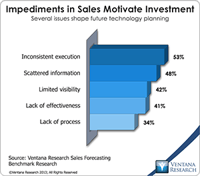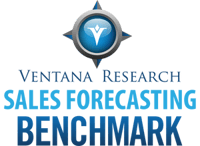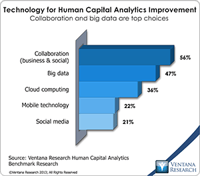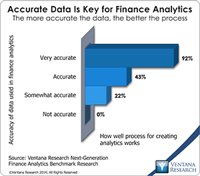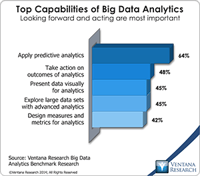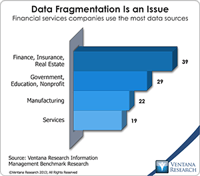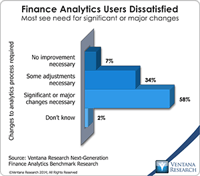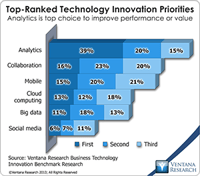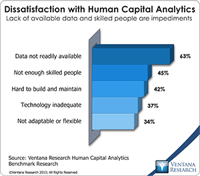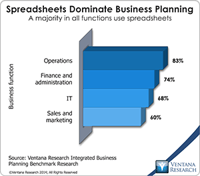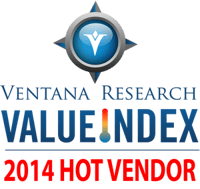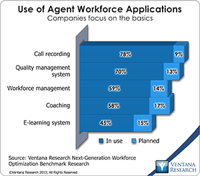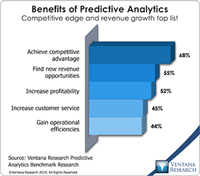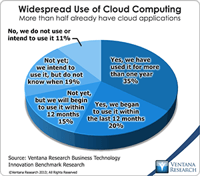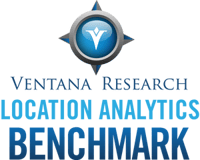Few sales organizations realize their full potential, partly because they don’t execute well. We urge organizations to move beyond conventional wisdom in how they think about executing sales processes and have placed methods for making improvement to sales execution at the center of our research on sales in 2014. In our recent research on sales forecasting almost half (44%) of sales organizations said they have impediments that are motivating management to consider further investment in sales...
Read More
Topics:
Sales,
Sales Performance,
Salesforce.com,
Qvidian,
Sales Coaching,
Sales Force Automation,
Operational Performance,
Business Analytics,
Cloud Computing,
SFA
Sales forecasting is an essential process for most businesses. It helps guide the efforts not only of the sales function but also of finance, operations, manufacturing and customer service. Our recently released sales forecasting benchmark research reveals significant insights and best practices that can help companies optimize the effectiveness of this process. I recently wrote that most sales organizations need to make significant changes to the way they do sales forecasting. In that analyst...
Read More
Topics:
Sales,
Sales Performance,
Sales Forecasting,
Operational Performance,
Business Analytics,
Business Intelligence,
Cloud Computing,
Information Applications,
SFA
Learning is an integral component of human capital management, and a new generation of learning management systems advances learning in organizations around the world. These systems have evolved over the years from a classroom scheduling tool that facilitated instructor-led and classroom training into an array of enterprise applications that deliver and track various types of training. Recently new technologies, such as business analytics, cloud computing, social collaboration, and mobile...
Read More
Topics:
Big Data,
Mobile,
Social Media,
HCM,
LMS,
Learning Management,
Analytics,
Business Analytics,
Business Collaboration,
Business Intelligence,
Cloud Computing,
Collaboration,
Workforce Performance,
HR,
Training,
benchmark,
HR research
Our research consistently finds that data issues are a root cause of many problems encountered by modern corporations. One of the main causes of bad data is a lack of data stewardship – too often, nobody is responsible for taking care of data. Fixing inaccurate data is tedious, but creating IT environments that build quality into data is far from glamorous, so these sorts of projects are rarely demanded and funded. The magnitude of the problem grows with the company: Big companies have more...
Read More
Topics:
Big Data,
Planning,
Predictive Analytics,
Governance,
Office of Finance,
Budgeting,
close,
Finance Analytics,
Tax,
Operational Performance,
Analytics,
Business Analytics,
Business Intelligence,
Business Performance,
CIO,
Financial Performance,
Governance, Risk & Compliance (GRC),
In-memory,
Information Applications,
CFO,
Risk,
CEO,
Financial Performance Management,
FPM
Organizations should consider multiple aspects of deploying big data analytics. These include the type of analytics to be deployed, how the analytics will be deployed technologically and who must be involved both internally and externally to enable success. Our recent big data analytics benchmark research assesses each of these areas. How an organization views these deployment considerations may depend on the expected benefits of the big data analytics program and the particular business case...
Read More
Topics:
Big Data,
Predictive Analytics,
Sales Performance,
Social Media,
Supply Chain Performance,
IT Performance,
Operational Performance,
Analytics,
Business Analytics,
Business Collaboration,
Business Intelligence,
Business Performance,
Cloud Computing,
Customer & Contact Center,
Financial Performance,
Operational Intelligence,
Workforce Performance,
Strata+Hadoop
The proliferation of chief “something” officer (CxO) titles over the past decades recognizes that there’s value in having a single individual focused on a specific critical problem. A CxO position can be strategic or it can be the ultimate middle management role, with far more responsibilities than authority. Many of those handed such a title find that it’s the latter. This may be because the organization that created the title is unwilling to invest the necessary powers and portfolio of...
Read More
Topics:
GRC,
Office of Finance,
Chief Risk Officer,
CRO,
ERM,
OpenPages,
Operational Performance,
Business Analytics,
Business Collaboration,
Business Performance,
Cloud Computing,
Data Governance,
Financial Performance,
IBM,
compliance,
Data,
Risk,
Financial Services,
FPM
Business computing has undergone a quiet revolution over the past two decades. As a result of having added, one-by-one, applications that automate all sorts of business processes, organizations now collect data from a wider and deeper array of sources than ever before. Advances in the tools for analyzing and reporting the data from such systems have made it possible to assess financial performance, process quality, operational status, risk and even governance and compliance in every aspect of a...
Read More
Topics:
Big Data,
Planning,
Predictive Analytics,
Governance,
Office of Finance,
Budgeting,
close,
Finance Analytics,
Tax,
Analytics,
Business Analytics,
Business Intelligence,
Business Performance,
CIO,
Financial Performance,
Governance, Risk & Compliance (GRC),
In-memory,
Information Management,
CFO,
Risk,
CEO,
Financial Performance Management,
FPM
SAP recently presented its analytics and business intelligence roadmap and new innovations to about 1,700 customers and partners using SAP BusinessObjects at its SAP Insider event (#BI2014). SAP has one of the largest presences in business intelligence due to its installed base of SAP BusinessObjects customers. The company intends to defend its current position in the established business intelligence (BI) market while expanding in the areas of databases, discovery analytics and advanced...
Read More
Topics:
Predictive Analytics,
SAP,
Business Objects,
IT Performance,
Analytics,
Business Analytics,
Business Intelligence,
Business Performance,
Customer & Contact Center,
KXEN,
Operational Intelligence,
HANA,
Lumira,
SAP insider
Pressure to comply with requirements of the Affordable Care Act (ACA) is a looming challenge for most organizations today. Many go through numerous manual iterations such as running reports and compiling data into spreadsheets from benefits, payroll and HR systems to calculate whether their employees are eligible. As my colleague Stephan Millard explains in “Is Your Organization Technology Ready for the Affordable Care Act?”, the ACA applies to organizations with 50 or more full-time employees...
Read More
Topics:
Equifax,
Human Capital Analytics,
Office of Finance,
Operational Performance,
Analytics,
Business Analytics,
Business Intelligence,
Business Performance,
Cloud Computing,
Financial Performance,
Governance, Risk & Compliance (GRC),
Information Applications,
Information Management,
Workforce Performance
Anaplan, a provider of cloud-based business planning software for sales, operations, and finance and administration departments, recently implemented its new Winter ’14 Release for customers. This release builds on my colleagues analysis on their innovation in business modeling and planning in 2013. Anaplan’s primary objective is to give companies a workable alternative to spreadsheets for business planning. It is a field in which opportunity exists. Our benchmark research on this topic finds...
Read More
Topics:
Big Data,
Performance Management,
Planning,
Predictive Analytics,
Sales Performance,
Supply Chain Performance,
Marketing,
Office of Finance,
Operations,
Reporting,
Budgeting,
Controller,
Operational Performance,
Business Analytics,
Business Performance,
Cloud Computing,
Financial Performance,
In-memory,
Workforce Performance,
CFO,
Sales Planning,
Financial Performance Management,
financial reporting,
FPM,
Integrated Business Planning
In the past year Kronos announced a major release of its Workforce Central suite and more recently, made an announcement regarding a major investment that should help keep the company well capitalized. Kronos is one of the largest vendors of workforce management systems, providing time and attendance, labor scheduling, absence management, HR management, payroll and recruiting applications. In 2013 the company grew to almost US$1 billion in revenue, selling to companies around the globe and...
Read More
Topics:
Mobile,
Social Media,
Governance,
HCM,
Kronos,
Office of Finance,
Technology Innovation Award,
Business Analytics,
Business Collaboration,
Business Intelligence,
Cloud Computing,
Collaboration,
Workforce Performance,
compliance,
HR,
HRMS,
Risk & Compliance (GRC),
Value Index,
Workforce Management,
Social
In my research of NICE Systems for several years I have remarked often that its biggest challenge is to integrate all the products that now make up its Customer Interaction Management suite. Through acquisitions, in-house development and partnerships, this suite has grown to include interaction recording, quality management, workforce management, incentive management, interaction analytics, performance management, real-time guidance, customer feedback management, mobile access and Web-based...
Read More
Topics:
Customer Analytics,
Customer Experience,
Customer Feedback Management,
Speech Analytics,
Voice of the Customer,
Mobile Apps,
Analytics,
Business Analytics,
Business Collaboration,
Cloud Computing,
Collaboration,
Customer & Contact Center,
Customer Service,
Call Center,
Contact Center,
Contact Center Analytics,
Desktop Analytics,
Text Analytics,
Workforce Force Optimization
SAS Institute, a long-established provider analytics software, showed off its latest technology innovations and product road maps at its recent analyst conference. In a very competitive market, SAS is not standing still, and executives showed progress on the goals introduced at last year’s conference, which I covered. SAS’s Visual Analytics software, integrated with an in-memory analytics engine called LASR, remains the company’s flagship product in its modernized portfolio. CEO Jim Goodnight...
Read More
Topics:
Predictive Analytics,
IT Performance,
LASR,
Operational Performance,
Analytics,
Business Analytics,
Business Intelligence,
Business Performance,
Cloudera,
Customer & Contact Center,
Hortonworks,
IBM,
Information Applications,
SAS institute,
Strata+Hadoop
There’s a growing realization that the multitenant approach to the cloud isn’t the only option that companies should weigh in deciding between deploying software on-premises and in the cloud. That some people describe the multitenancy approach as “the real cloud” reflects the contentious nature of some technical debates, especially those that occur early in the evolution of a new technology. Multitenancy does have advantages that confer cost savings, and these have been important in the first...
Read More
Topics:
Microsoft,
Mobile,
SaaS,
Sales,
Salesforce.com,
ERP,
HCM,
Human Capital,
Office of Finance,
Planview,
Concur,
Dynamics AX,
Dynamics GP,
Dynamics NAV Dynamics SL,
PSA,
Sage Software,
Unit4,
Analytics,
Business Performance,
Cloud Computing,
Financial Performance,
Workforce Performance,
CFO,
FinancialForce,
HR,
Infor,
Tagetik,
Workday,
Plex
Our latest benchmark research into the market for location analytics software finds significant demand for location-related technology that can improve business outcomes and generate relevant information for various types of users. (Location analytics is an extension of business analytics that can enhance the sophistication of data and processes by adding a geographic context.) My last analyst perspective on this topic discussed the business value of insights based on geography and what...
Read More
Topics:
Big Data,
Sales Performance,
Social Media,
Supply Chain Performance,
GIS,
Location Analytics,
IT Performance,
Operational Performance,
Business Analytics,
Business Collaboration,
Business Intelligence,
Business Performance,
Cloud Computing,
Customer & Contact Center,
Financial Performance,
Information Applications,
Information Management,
Location Intelligence,
Operational Intelligence,
Data
